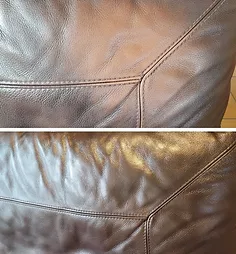
Experience the Unparalleled Benefits of Hand Cleaning Today!
Don’t settle for anything less than the best for your leather lounge.
Hand cleaning leather offers several benefits, making it a preferred method for maintaining and restoring leather items. Whether it’s leather furniture, or your car seat hand cleaning can help preserve the quality and appearance of your leather possessions. Here are some of the key advantages of hand cleaning leather:
Gentle and Controlled Cleaning: Hand cleaning allows you to have precise control over the cleaning process. You can apply the cleaning solution exactly where it’s needed, avoiding over-saturation or harsh scrubbing. This gentle approach minimizes the risk of damaging the leather’s surface.
Preservation of Natural Oils: Leather contains natural oils that help keep it supple and flexible. Hand cleaning typically involves using a mild, leather-specific cleaner that removes dirt and grime without stripping away these essential oils. This helps maintain the leather’s natural moisture balance.
Reduced Risk of Staining: Some leather items are susceptible to staining if exposed to excessive moisture or harsh cleaning agents. Hand cleaning with a leather-appropriate product reduces the risk of unintended discoloration or staining, preserving the leather’s color and finish.
Control Over Cleaning Agents: When you hand clean leather, you have the flexibility to choose the cleaning product that best suits the specific type of leather and the nature of the stains or dirt. Different leather types may require different cleaning solutions, and hand cleaning allows you to make this distinction.
Enhanced Cleaning of Problem Areas: Hand cleaning enables you to pay extra attention to areas with stubborn stains, spots, or heavy soiling. By gently massaging the cleaner into these problem areas with a soft cloth or sponge, you can effectively lift dirt and stains without damaging the leather.
Preservation of Patina: Leather develops a unique patina over time, which adds character and beauty to the material. Hand cleaning is a delicate method that helps preserve and enhance the patina, giving your leather items a distinctive and aged appearance.
Versatility: Hand cleaning is suitable for a wide range of leather items, including those with intricate details or delicate finishes. Whether you’re cleaning a vintage leather jacket, a luxury handbag, or an antique leather armchair, hand cleaning can be tailored to suit each item’s specific needs.
Environmentally Friendly: Hand cleaning leather often involves using eco-friendly and biodegradable cleaning products. This approach aligns with sustainable practices, reducing the environmental impact associated with leather cleaning.
Personal Connection: Hand cleaning allows you to engage with your leather items on a personal level. It can be a therapeutic and enjoyable process, fostering a sense of connection and care for your possessions.
In summary, hand cleaning leather is a gentle and effective method that offers numerous benefits, including the preservation of natural oils, reduced risk of staining, control over cleaning agents, enhanced cleaning of problem areas, and the preservation of the leather’s patina. It’s a versatile and environmentally friendly approach that allows you to maintain and restore your leather items while forming a personal connection with them.
We have a team of trained leather restore technicians using the most effective and safest methods for leather lounge cleaning.
We use mild, chemical-free cleaning agents and conditioners to remove soiling from the leather and restore it to a pristine condition. Gold Coast Leather Cleaning & Repairs can ensure that your leather couch looks its best.
Why Leather Cracks and Deteriorates?
Leather is a natural material that, over time, can deteriorate and break down due to a variety of factors. Understanding these reasons can help you take better care of your leather items and extend their lifespan. Here are the primary reasons why leather deteriorates and breaks down:
Lack of Moisture: Leather contains natural oils that keep it supple and flexible. When leather loses moisture, it becomes dry and brittle, leading to cracks and damage. Low humidity levels or exposure to dry environments can accelerate this process.
Exposure to Sunlight: Prolonged exposure to direct sunlight can cause leather to fade and lose its color. UV rays can also weaken the fibers of the leather, making it more susceptible to damage.
Temperature Fluctuations: Extreme temperature changes, especially heat, can cause leather to expand and contract. Over time, these fluctuations can weaken the leather, leading to cracks and stiffness.
Humidity Variations: Fluctuations in humidity levels can lead to leather expanding and contracting. Excessive moisture can also result in mold growth and the deterioration of the leather’s structure.
Dirt and Dust Accumulation: Dust and dirt particles can settle on the surface of leather items. Over time, these particles can act as abrasive agents, causing friction and wear that lead to surface damage and scuffs.
Stains and Spills: Accidental spills or exposure to liquids can leave stains on leather. If not promptly and properly cleaned, these stains can penetrate the leather and become difficult to remove, causing permanent damage.
Chemical Exposure: Contact with chemicals, including those found in cleaning agents, can harm leather. Harsh or inappropriate cleaning products can strip away natural oils, leading to dryness and deterioration.
Wear and Tear: Frequent use of leather items, such as shoes, handbags, and furniture, can subject the leather to wear and tear. Friction, pressure, and bending can weaken the leather fibers and cause cracks or tears.
Inferior Quality Leather: Low-quality leather, often processed with chemicals and lacking natural oils, is more prone to deterioration. The use of subpar materials can result in leather that breaks down more quickly.
Neglected Maintenance: Leather requires regular care and maintenance to stay in good condition. Neglecting to clean, condition, and protect leather items can accelerate their deterioration.
Age: As leather ages, it naturally undergoes changes in its structure and appearance. While this can contribute to a unique patina and character, it also makes the leather more susceptible to cracks and wear.
Inadequate Storage: Improper storage, such as storing leather items in damp basements or in direct contact with plastic, can promote mold growth, moisture retention, and deterioration.
Lack of Use: Surprisingly, leather items that are rarely used can also deteriorate. Without regular use and conditioning, the leather can become dry and susceptible to cracks.
In conclusion, leather deterioration and breakdown are natural processes influenced by a combination of environmental factors, usage patterns, and the quality of the leather itself. To extend the life of your leather items and minimize deterioration, it’s essential to provide proper care, protect them from adverse conditions, and address any stains or damage promptly.
We can repair these issues for you, onsite and with care. We repair by hand, with stitching, cleaning and colour matching.
We are fully equipped to fix all types of leather furniture issues. Gold Coast Leather Cleaning strives to deliver the best leather restore solutions at competitive prices.


UNDERSTANDING WHY STITCHING BREAKS ON YOUR LEATHER
Leather stitching can break for several reasons, ranging from natural wear and tear to issues related to the quality of the stitching and leather. Understanding these factors can help you prevent and address stitching problems effectively. Here are common reasons why leather stitching may break:
Normal Wear and Tear: Over time, the constant flexing and movement of leather items can put stress on the stitching. This stress can weaken the threads, leading to breakage.
Inferior Stitching Materials: Low-quality stitching materials, such as weak or thin threads, are more likely to break prematurely. Using strong and durable threads, like nylon or polyester, can help prevent stitching failures.
Inadequate Stitching Techniques: Poor stitching techniques, such as loose or uneven stitching, can weaken the seams. Skillful and precise stitching is crucial to ensuring the durability of leather items.
Tension Issues: If the stitching machine’s tension is not correctly adjusted, it can lead to overly tight or loose stitches, making the stitching prone to breaking.
Excessive Force: Applying excessive force to leather items, such as pulling or stretching beyond their limits, can put undue stress on the stitching, leading to breakage.
Abrasion and Friction: Constant rubbing or abrasion against rough surfaces can wear down stitching over time, causing it to weaken and eventually break.
Chemical Exposure: Exposure to harsh chemicals, including those found in cleaning agents or adhesives, can weaken stitching threads, making them more susceptible to breaking down.
Moisture and Humidity: Prolonged exposure to moisture and high humidity levels can cause leather to swell and shrink, which can put stress on the stitching, ultimately leading to breakage.
Temperature Fluctuations: Extreme temperature fluctuations can cause leather to expand and contract. Over time, this can weaken the stitching, especially if it’s not adequately reinforced.
Dryness and Lack of Conditioning: Leather needs moisture to remain supple and flexible. Dry leather can become brittle, and as it loses its natural oils, the stitching may become more susceptible to breaking.
Age: Leather items, especially older ones, can experience deterioration due to the aging process. As leather becomes more brittle and less pliable with age, the stitching can become weaker and more prone to breakage.
Inferior Leather Quality: The quality of the leather itself can affect the stitching’s durability. Low-quality or heavily processed leather may not provide a secure anchor for the stitching.
Insufficient Maintenance: Neglecting to clean, condition, and protect leather items can accelerate the aging and deterioration of both the leather and the stitching.
To prevent leather stitching from breaking, it’s essential to invest in high-quality stitching materials and techniques, use leather-appropriate adhesives and cleaners, avoid exposing leather to harsh conditions, and regularly maintain and condition your leather items. Additionally, promptly addressing any loose or damaged stitching can prevent more extensive issues from developing.
With Gold Coast Leather Cleaning you can rest assured we’ll repair with careful hand stitching broken seams, broken stitches, tears, and cuts can all be
We use heavy-duty upholstery threads to re-stitch an open seam on leather furniture.
Gold Coast Leather Cleaning will leave your leather couch looking great.
UNDERSTANDING COLOUR FADING ON YOUR LEATHER
The fading of color on leather furniture can occur for several reasons, primarily due to the exposure to various environmental factors and the natural characteristics of leather. Understanding these reasons can help you take steps to prevent or minimize color fading. Here are the common reasons why color fades on leather furniture:
UV Radiation: Exposure to ultraviolet (UV) radiation from sunlight is one of the leading causes of color fading in leather furniture. UV rays can break down the pigments and dyes used in the leather, causing them to fade over time.
Direct Sunlight: Leather furniture placed in direct sunlight is particularly susceptible to color fading because it receives more intense UV exposure. Overexposure to sunlight can result in uneven fading and a loss of vibrancy.
Low-Quality Dyes: Leather furniture made with low-quality dyes or pigments is more prone to fading. High-quality leather furniture typically uses superior dyes that are more resistant to fading.
Dye Transfer: The dye from clothing, especially denim and fabrics with strong dyes, can transfer onto leather furniture. Over time, this can cause discoloration and fading of the original leather color.
Heat: High temperatures can accelerate color fading. Leather furniture placed near heat sources like radiators, heaters, or fireplaces is at greater risk of experiencing color loss.
Humidity Fluctuations: Fluctuations in humidity levels can cause leather to expand and contract. This continuous movement can lead to color fading over time, especially in regions with extreme humidity changes.
Airborne Contaminants: Airborne pollutants, such as dust, smoke, and pollutants from cooking, can settle on leather furniture and contribute to color fading. These contaminants can also degrade the leather’s protective finish.
Chemical Exposure: Exposure to harsh cleaning agents, solvents, or chemicals not designed for leather can strip away the dye and color from the leather’s surface.
Abrasion and Friction: Frequent contact with rough or abrasive surfaces can wear away the dye or pigments on the leather, causing color fading.Aging: As leather ages, it naturally undergoes changes in color and appearance. While this can result in a desirable patina, it can also lead to color fading, especially if the leather is not adequately maintained.
Neglected Maintenance: Failure to clean and condition leather furniture regularly can leave the leather’s surface vulnerable to damage and color fading.
To prevent color fading on leather furniture, consider the following precautions:
By taking these precautions and maintaining your leather furniture properly, you can prolong its vibrant color and extend its lifespan.
So wether is sweat, body oils, sunlight, and other stressors can cause colour fading to your leather
Let us improve your furniture’s appearance by restoring your faded leather lounge.
If you have any questions about our services, please get in touch with us.
We are Gold Coast leather cleaning + repair
